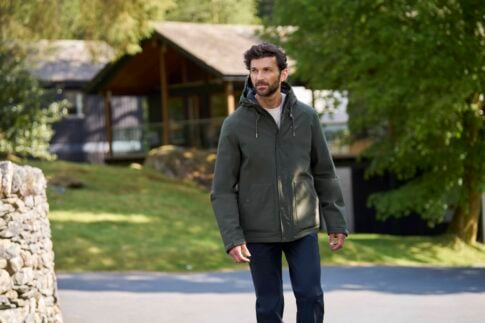

A softshell is a versatile jacket that is suitable for many outdoor activities, but what exactly is a softshell jacket?
A soft shell jacket is a made from a woven material in contrast to the stiffer material of hardshell (or waterproof) jackets. Unlike conventional jackets a softshell jacket does not have a lining but instead is made by bonding two layers of fabric together.
They are designed to bridge the gap between a fleece, which offers less water resistance and protection from the wind, and a waterproof jacket which is less stretchy.

Softshells usually have more breathability, and although hardshells can also be breathable, they are stiffer than softshells to provide better weather protection.
There are two types of softshell jacket; stretch-woven or membrane. A stretch-woven soft shell jacket has a water repellent coating whilst in a membrane softshell a waterproof membrane is bonded between the two layers of fabric. Neither softshell jackets are 100% waterproof as they do not have taped seams to stop water entering in at the stitched areas.
Stretch-woven softshell jackets are more breathable than membrane softshells and are popular for active pursuits such as running or cycling. Membrane softshells may be slightly heavier than stretch-woven options and are more suited to outdoor activities where you might need more protection from the elements.
Stretch-Woven
| Pros | Cons |
| Better breathability than Membrane | Only water resistant not fully waterproof |
| Lighter weight | May not be windproof |
| Ideal midlayer under a waterproof jacket | Not as lightweight as a fleece |
Membrane
| Pros | Cons |
| More waterproof than a stretch woven jacket | Often heavier than a stretch woven jacket |
| More breathable than a hardshell jacket | Not as breathable as a stretch woven jacket |
| Offers protection against the elements | Not as waterproof as a hardshell jacket |
Stretch-woven softshell jackets are only showerproof, not fully waterproof. They are the ideal outer layer for fair weather activities but are not suited if you expect heavy rain, where a hard membrane softshell or hardshell jacket would be more appropriate.
However, stretch-woven softshells are a great mid layer for cold conditions, and can be worn under a waterproof jacket for added warmth as a windproof layer.
A membrane softshell, with a built in waterproof layer, is suitable for less favourable conditions and can be worn in just about any weather.

Softshell jackets are the ideal mid layer when conditions are particularly cold and you need something a bit more robust than a fleece. A softshell can also be worn over a base layer or t-shirt as an outer layer due to their showerproof and windproof capabilities.
Here are a few key factors to consider when buying:
– Weather conditions
– What you will be wearing the jacket for
– Style and fit
– Your budget
The type of softshell you choose will depend on the activity you indeed to use it for. For activities such as climbing, fair weather hiking and cycling where you need a lightweight outer layer, a stretch-woven softshell jacket is ideal.
Some softshell jackets are fleece lined for added warmth. These are ideal if you are not necessarily looking for a jacket to use during strenuous activities, but want something lightweight to wear on a day to day basis.
If you’re looking for a softshell for more active purposes and you don’t need quite as much warmth, then an unlined softshell would be more suitable. Without the fleece lining you still have the option of layering up underneath if you so wish. For cycling or running a thinner, breathable softshell is ideal.
Softshell jackets are generally short in length and should be worn quite tight fitting. The stretchy material means there is still a good range of movement, but the tighter fit helps to retain heat.
As well as their technical properties, the shorter fit and style makes them a popular choice as a casual every day jacket.